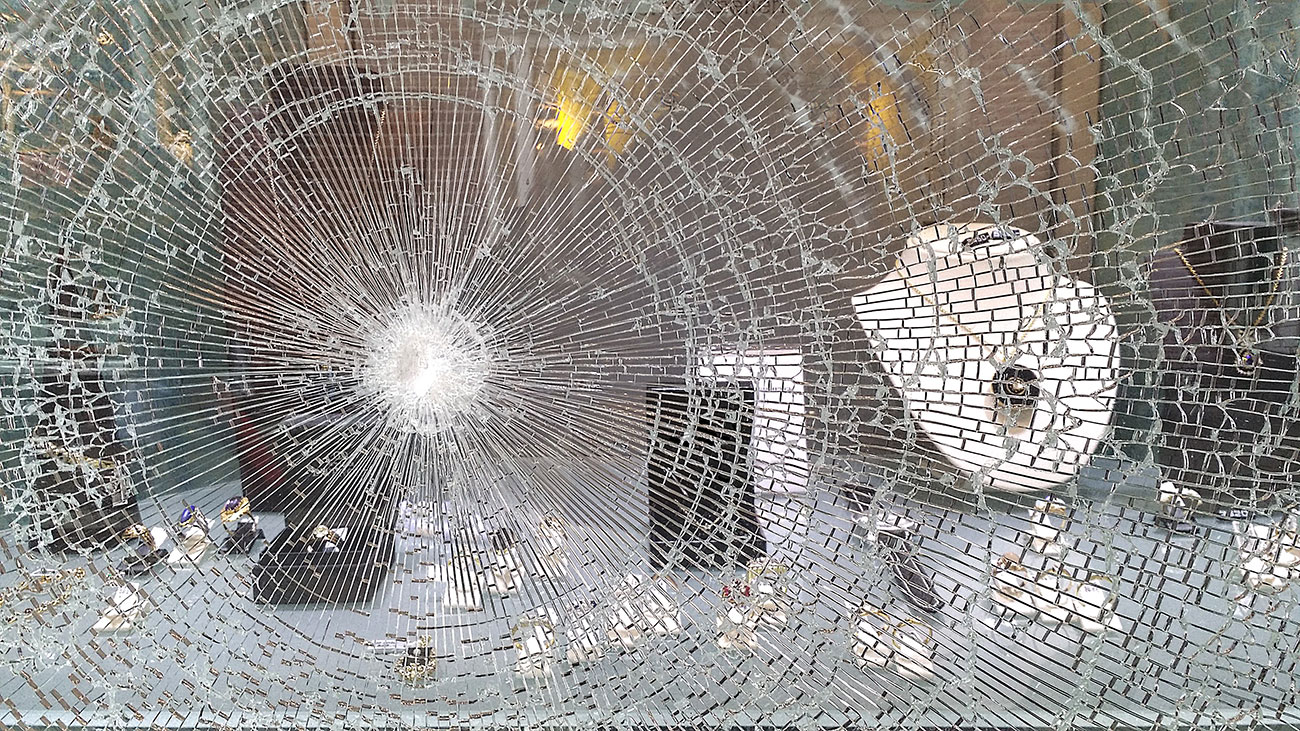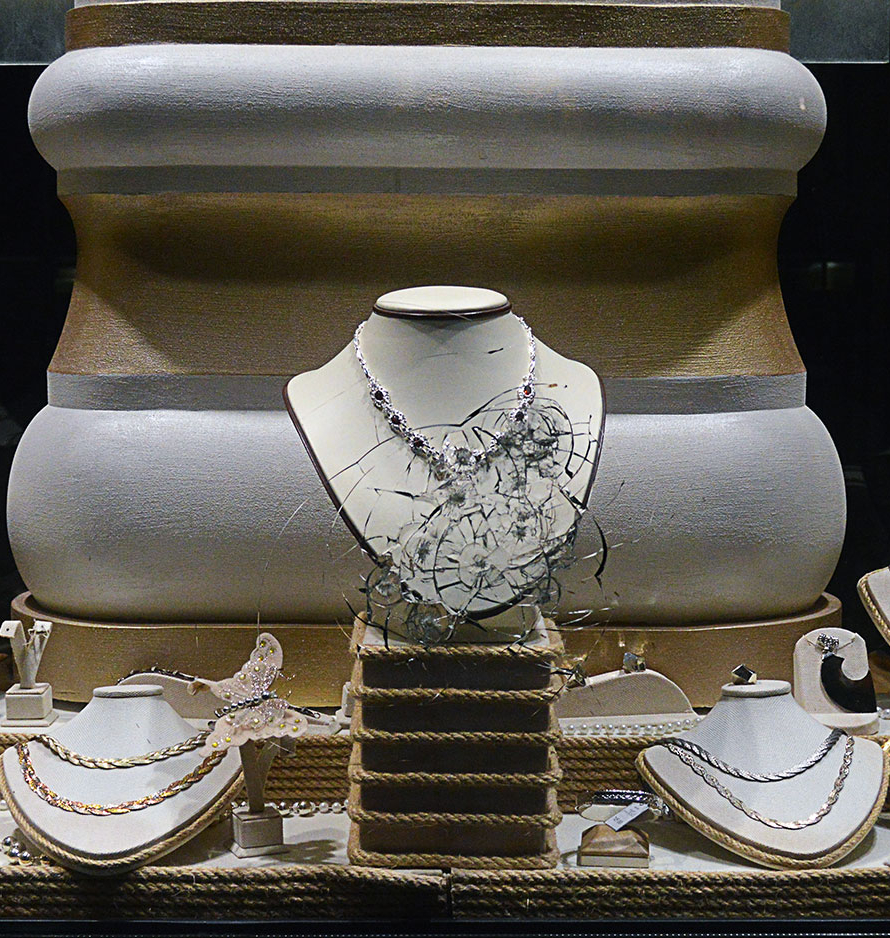The fear of crime has risen over the past couple of years. For jewelers—retailers in particular—there is a pervasive sense that they are on the front lines.

“I’ve never seen jewelers as nervous as they are now about crime,” says John Kennedy, president of Jewelers’ Security Alliance (JSA) in New York City.
This perception is borne out by the numbers, Kennedy adds. Historically, crime figures for the jewelry industry have been stable on a year-to-year basis. The total annual crime count documented by JSA would generally range between 1,300 and 1,600. But last year saw a remarkable—and alarming—shift. “There was a 27% increase from 2021 to 2022 in the number of crimes the U.S. industry experienced,” Kennedy says. “In 2022, there were 2,141 total incidents. We’d never gone over 1,600 incidents in a year before.”
John Fierst, vice president of global risk services and analytics at Jewelers Mutual Group in Neenah, Wis., also reports a recent jump in criminal activity. “Looking at 2022 compared to 2021, burglaries were up 20% year to year,” he says. “Robberies were up 76% year to year in the number of incidents, which is really concerning.”
Robbery is especially worrisome because it can endanger workers and discourage customers from shopping. “It’s a big concern,” Fierst says. “Can this have a negative perception on our industry? Do customers feel safe going to stores?”
Tempting targets for thieves
Stand-alone jewelry stores and jewelry retailers located in strip malls are vulnerable to burglary, often by criminals with the technological prowess to disable security system alarms and cameras, Kennedy says. “Burglars today attack the electrical junction box of the store,” he says. “Sometimes it’s very sophisticated.”

But Kennedy adds that an “overwhelming” amount of retail theft occurs in mall stores. These crimes tend to be grab-and-run or smash-and-grab robberies. “Jewelry crime is sometimes a crime of opportunity,” says Patricia Low, president and CEO of Mahwah, N.J.–based Coverage Solutions 1976, provider of Jewelers UnBLOCKed insurance. “If this is a store that has its exterior doors open, it’s what’s easy. Malls are particularly problematic because there’s less deterrent to enter.” What’s more, the crowds that used to inhibit getaways disappeared during the pandemic and in many areas haven’t returned to pre-pandemic levels.
Fewer mall shoppers can mean fewer employees for cost-conscious retailers—another lure to thieves. “Having more staff on the floor is helpful because it’s harder for the bad guys to maneuver when there’s more people there,” says Gregory J. Smith, executive vice president of Berkley Asset Protection, an insurance provider based in New York City.
Many shopping malls hire security guards to patrol their corridors, but tenants’ options for providing their own professional security may be limited. Smith says mall regulations often prohibit stores from hiring private security or pursuing a fleeing criminal. “Mall security probably isn’t as robust as it was in the past,” he says. “Mall security probably will not tackle anyone today in trying to stop them from leaving because the risk of getting sued has increased.”
Retail jewelry stores aren’t the only potential victims of the current crime surge. While COVID-19 temporarily put the kibosh on trade-show-related crimes, Kennedy says industry events are once again an attractive target for crooks. “We’re seeing a big return of the criminals to the trade shows,” he says. One way thieves operate is to sneak in before hours or during the show setup disguised as workers or maintenance crew. “You must have control of your product at all times,” Kennedy says.

The costs of higher crime

Some experts say changes in community standards, law enforcement, and prosecutions are drivers of higher crime rates. “Criminals are not being prosecuted as they once were,” Smith says. “There seems to be some more organization to the smash-and-grab theft and, with the lack of prosecution, this is going to unfortunately continue.”
Not only did the number of industry-related crimes jump last year, but the dollar value of those stolen goods rose by a whopping 70%, Kennedy says. This increase has had a noticeable effect on insurance premiums.
“Insurance pricing across all companies is going up, and there are a number of reasons,” Fierst says. Inflation has pushed up the prices of gold and other commodities as well as replacement materials needed for repairing windows, showcases, and wiring damaged by thieves. A couple of punishing years for the property-casualty sector in general, fueled by hurricanes and wildfires, has driven up reinsurance premiums.
But the higher volume of criminal activity is a key culprit, Fierst says. “It’s just the sheer volume of losses, and it doesn’t appear to be letting up.”
Protecting your employees and inventory

The experts we spoke to advise several steps you can take immediately to help secure your property and protect the safety of your employees. For starters, Kennedy recommends making yourself aware of local crime statistics, increases, or waves of retail theft in your area.
During business hours, it helps if you can control access or limit the number of customers at a time and make sure you can see the faces of everyone who enters, Fierst says. “I’d encourage removing hats, sunglasses, and masks so you can get a positive ID having a camera at eye level.” If someone wants to try on an especially expensive piece, ask for a driver’s license or other ID. “Never show more than one item at a time, and never let that item out of your sight,” Fierst advises.
And be wary of big groups, Fierst adds. “It’s very infrequent that a legitimate customer will come in with a group of more than two or three,” he says. If a large number of people enter your store together, have a code or a signal to get all your employees—back-office ones, too—onto the showroom floor to help act as lookouts.
Practice proper safety protocols when opening and closing your store, and train your staff to do the same, the experts say.

“What people need now is to put away more merchandise,” says Gary Wasserman, vice president of Wexler Insurance Agency (whose parent company is Jewelers Mutual Group). “Put your stuff away, lock it up at night, leave less out.” It might take a few more minutes, he says, but that’s much less time than you’d invest pursuing a theft claim.
“You need to be really diligent at that point that all your doors are locked before your safe is open,” Low says. “The challenge is to remain constantly vigilant,” she adds, because it only takes a momentary lapse to be victimized.
Need more guidance? In March, Jewelers Mutual launched a series of online tutorials for retail managers and staff members developed in conjunction with JSA. Within weeks of its debut, a Jewelers Mutual spokesperson said hundreds of users had already enrolled on the platform to access the training modules.
(Top photo: Getty Images)
